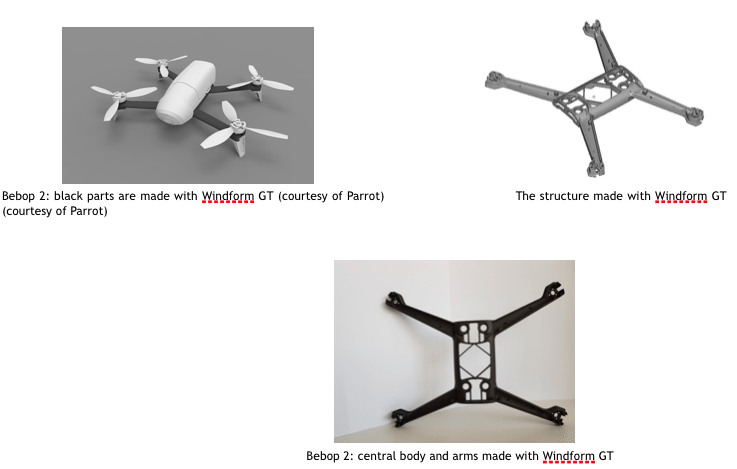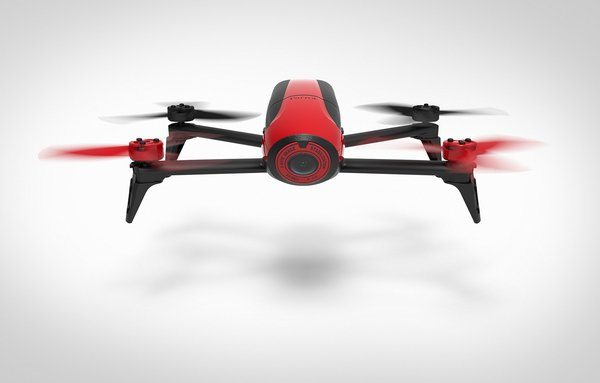The body, built with Selective Laser Sintering technique and innovative Windform GT Additive Manufacturing material, combines excellent aesthetic results in excellent resistance to impact and temperature changes
Reinforced composite materials that were used in the construction of on-car and wind tunnel parts and components for racing teams have taken the technology of 3D Printing to new heights to produce parts for the entertainment industry and consumers. The case-study describes the construction of the first leisure drone: Bebop 2.
Parrot Bebop 2 combines robustness and reliability in a lightweight and compact drone. Powerful with impressive stability and maneuverability even in extreme conditions, Bebop 2 offers very easy-to-use piloting with no learning. Data collected by seven sensor are analyzed and merged thanks to the impressive calculation capability of its onboard computer. Bebop 2 integrates a front facing camera specifically design for it. Pilot can digitally change the angle of the camera by 180° by just sliding a finger on the screen of the piloting device. Digitally stabilized on 3-axis thanks to powerful algorithms, images are bright, perfectly stable and without distortion regardless of the drone movements.
Parrot has developed the final Bebop 2 version with the help of Windform GT material.
The first Bebop 2 structure was built on injected parts made with polyamide based glass reinforced composite material. Then Parrot moved to SLS (Selective Laser Sintering) technology in collaboration with CRP Technology in order to optimize the structure performance without developing long lead time and high cost injection tooling, accelerate iteration generation, improve manufacturing time, facilitate production in series. The Bebop 2 parts in Windform GT are the main structure (central body) and all singles arms. The body is robust and flexible, and the arms are reinforced
Parrot carried out an original development approach based on experimental diagnosis and FE model aimed at improving the quality of the video during flight (which is usually altered by the vibrations of the drone) through the optimization of drone design.
The structure has been manly developed according to that target and by finding smart design to reduce weight.
Parrot has established that the natural frequencies of the parts made with Windform GT were quite similar to those of parts obtained by injection molding technique applied to glass fiber reinforced polyamide.
Parrot validated that natural frequencies of parts manufactured with Windform GT material were similar to injected parts with polyamide based glass reinforced composite material. Combined to FE analysis Parrot has reduced dramatically the development time.
Parrot was also able to evaluate toughness of the product structure (a consumer drone as Bebop 2 is a flying machine led to fall quite often with beginners).
Windform GT proved the only material for 3D Printing technologies able to overcome the accidental fall of tests carried out by Parrot’s technicians.
Parrot highlights others advantages obtained with Additive Manufacturing and Windform GT material: make small batches of production with acceptable mechanical properties to provide functional products to the team (i.e. very helpful to develop others product’s functionalities like flying performances), good aesthetics feature.
By CRP Technology point of view the requirements were fast iteration process, best ratio between structural strength and weight, acceptable consistent result and opportunity to combine multiples functionalities from one unique part.
CRP Technology provided fast response time to new requirements, very good cooperation with its engineers and CAD designers, and best output quality with unique proprietary process.
About PARROT
Founded in 1994 by Henri Seydoux, Parrot creates, develops and markets advanced technology wireless products for consumers and professionals.
The company builds on a common technological expertise to innovate and develop in three primary markets:
- Civil drones: With recreational quadricopters and solutions for professional use.
- Connected objects: With a focus in audio and gardening.
- Automotive: With the most extensive range of hands-free communication and infotainment system for vehicles on the market.
Headquartered in Paris, Parrot currently employs more than 1.000 people worldwide and generates the majority of its sales overseas.
Parrot has been listed on Euronext Paris since 2006. (FR0004038263 – PARRO)
For more information, please visit www.parrot.com
About CRP Technology
CRP Technology is based in Modena, Northern Italy, in the area of the so-called Italian Motor Valley.
CRP Technology is one of CRP Group’s five specialized divisions. Each reality is an example of excellence in its target sector. With more than 45 years of experience in the world of F1 alongside the major international teams, the CRP Group is distinguished by its know-how in specific application fields: with its emphasis on customization, high-end technologies, a broad range of applications and customer service, the CRP Group maintains a strong relationship with client companies and entrepreneurs in the fields of the automotive industry and motorsports, design, aerospace, Unmanned Aerial Vehicles (UAVs), the marine, entertainment and packaging.
Specifically the activity of CRP Technology is dedicated to additive manufacturing, ranging from the motorsport industry to the aviation, aerospace industry and UAV. CRP Technology also produces and sells composite materials for additive manufacturing, called Windform. The family of Windform materials is composed of: Windform XT 2.0, Windform LX 2.0, Windform GT, Windform SP. Each material is characterised by mechanical features that make them the suitable materials for several applications.
CRP Technology has long expertise in the technique of Selective Laser Sintering in high-performing sectors. They worked together with the most important racing teams at worldwide level, in particular in the building of parts and components that were tested in wind tunnel, but also used on track for the race.
About Windform® materials
Windform® materials are laser sintering materials for 3D printing and additive manufacturing. Windform composite SLS materials were born from the study-research of R&D department of CRP Technology and international market needs.
Windform® is the ideal composite SLS material that is able to satisfy the needs of international market of Additive Manufacturing. The SLS materials Windform® can guarantee: originality, innovation, reliability, and mechanical performances.
About Windform® GT
CLASS OF MATERIAL: Polyamide composite material
TECHNOLOGY: Selective Laser Sintering
- Windform GT is a polyamide based glass microfiber reinforced composite material with a dark black color.
- After hand polishing, the material is smooth with a deep lustrous finish. Windform GT is a flexible product in the Windform family of materials for additive manufacturing, not only aesthetically, but also in terms of performance.
- Windform GT combines the optimal characteristics of elasticity, ductility, and resistance to impact. Thus, it can be considered a highly valuable material in various racing and functional applications in regards to vibration and shock.
- The material’s superior values in regards to impact strength and elongation at break, combined with its tensile and flexural strength, makes it ideal for applications where resistance to “damage” is a prerequisite in order to preserve internal components in the event of impact and/ or improper use.
- Windform GT is also a waterproof material, with resistance to the absorption of moisture and liquids. It is also very light with excellent mechanical properties per unit density.
Applications:
For automotive applications which require specific flexibility in the car and under the hood (such as snap fit components). It is also suitable for motorsports, air ducts, intake and cooling systems, hydraulic ducts in contact with liquids or oils, protective covers for sensors, and for all applications that need flexibility and resistance to damage (for example: racing components near the ground).
These applications indicated are just examples. The versatility of the product combined with the technology used allows for near endless possibilities.





